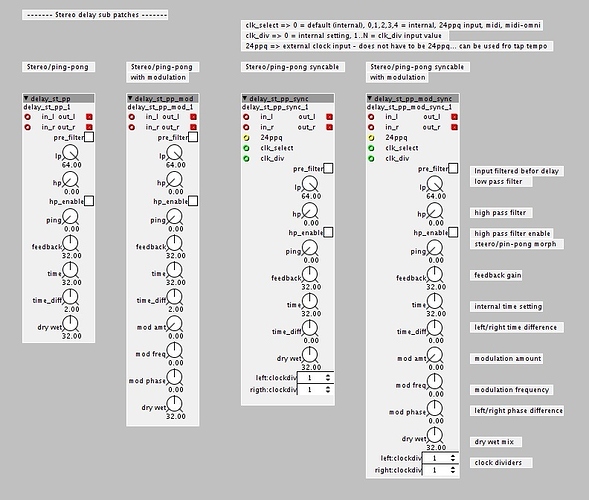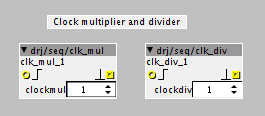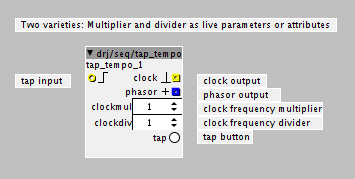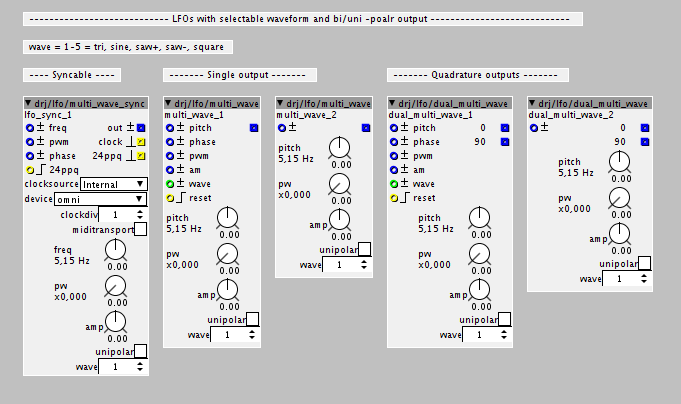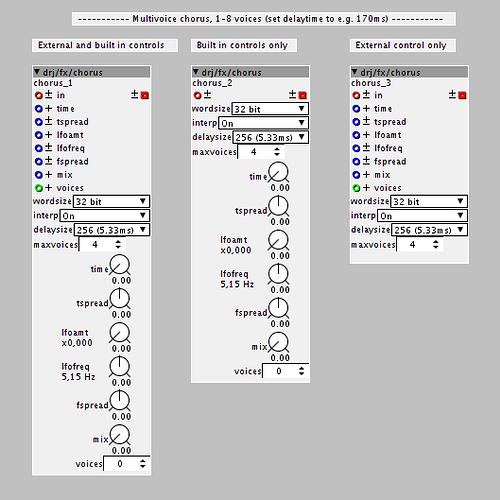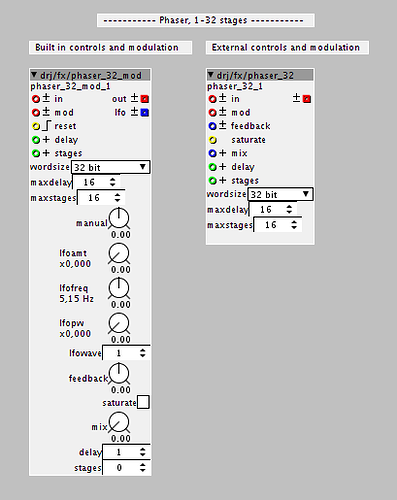Chorus and phaser modules and subpatches
drj/fx/chorus - multi voice chorus with built in and external controls
drj/fx/chorus - multi voice chorus with built in control
drj/fx/chorus - multi voice chorus with external controls
drj/fx/phaser_32_mod - phaser with built in controls and modulation
drj/fx/phaser_32 - phaser with external controls and modulation
subpatches
axoloti/axoloti-contrib/patches/drj/fx/stereo_chorus.axs - stereo chorus subpatch
axoloti/axoloti-contrib/patches/drj/fx/stereo_phaser.axs - stereo phaser subpatch
demo patches
axoloti\axoloti-contrib\patches\drj\demo\test_stereo_chorus.axs - stereo chorus demo patch
axoloti\axoloti-contrib\patches\drj\demo\test_stereo_phaser.axs - stereo phaser demo patch
axoloti\axoloti-contrib\objects\drj\fx\stereo_phaser_info.axh - stereo phaser demo patch (phaser help patch)
status
Ready to use
chorus description
The chorus modules are all the same except for the io and controls. They can be configured for up to 8 voices, use a lower maximum to save some memory. There is a parameter to control the number of currently active voices and the CPU usage varies accordingly.
Attributes:
wordsize: Selects the wordsize for the delay line, 32, 16, 12, 8 or 4 bits.
interp: Enables or disables delay line interpolation.
delaysize: Size of the delay line.
maxvoices: The maximum number of active voices, 1-8.
Parameters and inlets:
time: The base delay time.
tspread: The spread of the delay times. Positive values increase the times for higher numbered voices, negative values decrease the times for higher numbered voices.
lfoamt: Amount of LFO modulation.
lfofreq: The base LFO frequency.
fspread: The spread of the LFO frequencies. Positive values increase the frequencies for higher numbered voices, negative values decrease the frequencies for higher numbered voices.
mix: Dry/wet mix.
voices: The number of currently active voices. The inlet is added to the parameter value.
I recommend a time setting of 85.33ms or 170ms, using the lower range of the time parameter for typical chorus sounds. Use lower wordsizes and no interpolation to dirty it up if needed, The fspread parameter must be non-zero for proper movement with more than 1 voice. The fspread and tspread parameters gives a large range of chorus sounds, so tewak away. 3-4 voices give nice fat chorus - use 1 voice for vibrato, or just slight fattening - 8 voices is just ridiculous, but if you want, you can...
phaser description
The phaser modules come in two varieties: one with built in controls and modulation and one for external control and modulation They can be configured for up to 32 stages. There is a parameter to control the number of currently active stages and the CPU usage varies accordingly.
Attributes:
wordsize: Selects the wordsize for the all pass delay lines, 32 or 16 bits.
maxdelay: Maximum size of the delay lines, 1-32.
maxstages: The maximum number of active stages, 1-32.
Parameters and inlets:
manual: Base frequency.
lfoamt: Amount of LFO modulation.
lfofreq: The LFO frequency.
lfopw: Pulse width fro the LFO square wave.
lfowave: LFO waveform, 1-5 = tri, sine, saw+, saw-, square.
reset: Resets the phase of the LFO.
feedback: Amount of feedback.
saturate: Soft saturation in the feedback loop.
mix: Dry/wet mix.
delay: Size of delay in samples. The inlet is added to the parameter value.
stages. Number of active stages. The inlet is added to the parameter value.
Use low delay sizes for classic phaser sounds, larger ones for more spacey sounds. Tweaking the manual, lfo, feedback and stages controls gives varying sounds, from subtle phasing to a flanging like effect. Check out axoloti\axoloti-contrib\objects\drj\fx\stereo_phaser_info.axh for some examples (it's the help patch for the phaser modules).

